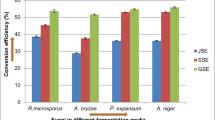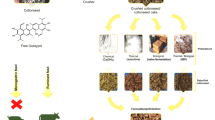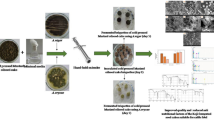Abstract
Poultry and swine are the major proportion of the livestock industry in terms of output value. To meet the growing need for protein sources in these sectors, the use of biomasses coming from agro-industrial residues can be an interesting option in the future years. This study aimed to evaluate the capacity of seven basidiomycetes to grow, detoxicate, increase protein content, and its antioxidant activity when grew in pure Jatropha seed cake (JSC) and cottonseed cake (CSC) biomasses and mixtures containing 50% of lignocellulosic biomasses from coconut husks and Acrocomia aculeata (macauba cake). Results showed that five basidiomycetes were able to grow in these substrates. F. hepatica, P. lecomtei, and P. pulmonarius presented the highest bio-detoxification capacity. All treatments showed a reduction in total phenolic compounds and antioxidant activity, but treatments with coconut husks showed lower reductions. Results also indicated that there were molecules produced by basidiomycetes responsible for antioxidant activity other than phenolic compounds. These results indicated that basidiomycetes could detoxify JCS and CSC biomasses, suggesting their possible use in animal feed and that the addition of coconut husks in JSC and macauba cake in cottonseed cake could promote greater colonization by fungi.
Graphic Abstract



Similar content being viewed by others
Availability of Data and Material
Not applicable.
Code availability
Not applicable.
References
Gomes, T.G., Hadi, S.I.I.A., Costa Alves, G.S., Mendonça, S., De Siqueira, F.G., Miller, R.N.G.: Current strategies for the detoxification of Jatropha curcas seed cake: a review. J. Agric. Food Chem. 66, 2510–2522 (2018). https://doi.org/10.1021/acs.jafc.7b05691
Gadelha, I.C.N., Fonseca, N.B.S., Oloris, S.C.S., Melo, M.M., Soto-Blanco, B.: Gossypol toxicity from cottonseed products. Sci. World J. 2014, 1–11 (2014). https://doi.org/10.1155/2014/231635
Soares Neto, C.B., Conceição, A.A., Gomes, T.G., et al.: A comparison of physical, chemical, biological and combined treatments for detoxification of free gossypol in crushed whole cottonseed. Waste Biomass Valor (2020). https://doi.org/10.1007/s12649-020-01290-0
de Barros, C.R.M., Ferreira, L.M.M., Nunes, F.M., Bezerra, R.M.F., Dias, A.A., Guedes, C.V., Cone, J.W., Marques, G.S.M., Rodrigues, M.A.M.: The potential of white-rot fungi to degrade phorbol esters of Jatropha curcas L. seed cake. Eng. Life Sci. 11, 107–110 (2011). https://doi.org/10.1002/elsc.201000040
Philippoussis, A., Zervakis, G., Diamantopoulou, P.: Bioconversion of agricultural lignocellulosic wastes through the cultivation of the edible mushrooms Agrocybe aegerita, Volvariella volvacea and Pleurotus spp. World J. Microbiol. Biotechnol. (2001). https://doi.org/10.1023/A:1016685530312
Cavalcanti-Oliveira, E.D., Silva, P.R., Rosa, T.S., Moura, N.M.L., Santos, B.C.P., Carvalho, D.B., Sousa, J.S., Carvalhinho, M.T.J.E., Castro, A.M., Freire, D.M.G.: Methods to prevent acidification of Macauba (Acrocomia aculeata) fruit pulp oil: a promising oil for producing biodiesel. Ind. Crops Prod. (2015). https://doi.org/10.1016/j.indcrop.2015.09.022
Miles, P.G., Chang, S.-T.: Mushroom Biology. In Mushroom Biology. World Scientific, Singapore (1997)
Bach, F., Helm, C.V., Bellettini, M.B., Maciel, G.M., Haminiuk, C.W.I.: Edible mushrooms: a potential source of essential amino acids, glucans and minerals. Int. J. Food Sci. Technol. (2017). https://doi.org/10.1111/ijfs.13522
Rashidi, A., Yang, T.: Nutritional and antioxidant values of oyster mushroom (P. sajor-caju) cultivated on rubber sawdust. Int. J. Adv. Sci. Eng. Inf. Technol. (2016). https://doi.org/10.18517/ijaseit.6.2.610
Dias, E.S., Abe, C., Schwan, R.F.: Truths and myths about the mushroom Agaricus blazei. Sci. Agricol. 61(5), 545–549 (2004)
Hetland, G., Johnson, E., Lyberg, T., Bernardshaw, S., Tryggestad, A.M.A., Grinde, B.: Effects of the medicinal mushroom Agaricus blazei Murill on immunity, infection and cancer. Scand. J. Immunol. (2008). https://doi.org/10.1111/j.1365-3083.2008.02156.x
Bisen, P.S., Baghel, R.K., Sanodiya, B.S., Thakur, G.S., Prasad, G.: Lentinus edodes: a macrofungus with pharmacological activities. Curr. Med. Chem. (2010). https://doi.org/10.2174/092986710791698495.34(1),66-71(2003)
Ruán-Soto, F., Garibay-Orijel, R., Cifuentes, J.: Process and dynamics of traditional selling wild edible mushrooms in tropical Mexico. J. Ethnobiol. Ethnomed. (2006). https://doi.org/10.1186/1746-4269-2-3
Kües, U., Liu, Y.: Fruiting body production in basidiomycetes. Appl. Microbiol. Biotechnol. (2000). https://doi.org/10.1007/s002530000396
Carrasco-González, J.A., Serna-Saldívar, S.O., Gutiérrez-Uribe, J.A.: Nutritional composition and nutraceutical properties of the Pleurotus fruiting bodies: Potential use as food ingredient. J. Food Compos. Anal. (2017). https://doi.org/10.1016/j.jfca.2017.01.016
Liktor-Busa, E., Kovács, B., Urbán, E., Hohmann, J., Ványolós, A.: Investigation of Hungarian mushrooms for antibacterial activity and synergistic effects with standard antibiotics against resistant bacterial strains. Lett. Appl. Microbiol. (2016). https://doi.org/10.1111/lam.12576
Ribeiro, B., Valentão, P., Baptista, P., Seabra, R.M., Andrade, P.B.: Phenolic compounds, organic acids profiles and antioxidative properties of beefsteak fungus (Fistulina hepatica). Food Chem. Toxicol. (2007). https://doi.org/10.1016/j.fct.2007.03.015
Vargas-Isla, R., Capelari, M., Menolli, N., Jr., Nagasawa, E., Tokimoto, K., Ishikawa, N.K.: Relationship between Panus lecomtei and P. strigellus inferred from their morphological, molecular and biological characteristics. Mycoscience 56, 561–571 (2015). https://doi.org/10.1016/j.myc.2015.05.004
Zmitrovich, I.V., Kovalenko, A.E.: Lentinoid and polyporoid fungi, two generic conglomerates containing important medicinal mushrooms in molecular perspective. Int. J. Med. Mushrooms (2016). https://doi.org/10.1615/IntJMedMushrooms.v18.i1.40
Cör, D., Botić, T., Knez, Ž, Batista, U., Gregori, A., Pohleven, F., Bončina, T.: Two-stage extraction of antitumor, antioxidant and antiacetylcholinesterase compounds from Ganoderma lucidum fruiting body. J. Supercrit. Fluids (2014). https://doi.org/10.1016/j.supflu.2014.04.006
Cör, D., Knez, Ž, Knez Hrnčič, M.: Antitumour, antimicrobial, antioxidant and antiacetylcholinesterase effect of Ganoderma lucidum terpenoids and polysaccharides: a review. Molecules (2018). https://doi.org/10.3390/molecules23030649
Tiseo, K., Huber, L., Gilbert, M., Robinson, T.P., Van Boeckel, T.P.: Global trends in antimicrobial use in food animals from 2017 to 2030. Antibiotics (2020). https://doi.org/10.3390/antibiotics9120918
Makkar, H.P.S., Becker, K., Sporer, F., Wink, M.: Studies on nutritive potential and toxic constituents of different provenances of Jatropha curcas. J. Agric. Food Chem. (1997). https://doi.org/10.1021/jf970036j
Conceição, A.A., Soares Neto, C.B., de Ribeiro, J.A., de Siqueira, F.G., Miller, R.N.G., Mendonça, S.: Development of an RP-UHPLC-PDA method for quantification of free gossypol in cottonseed cake and fungal-treated cottonseed cake. PLoS ONE 13, 10196164 (2018). https://doi.org/10.1371/journal.pone.0196164
Ng, H.-E., Raj, S., Wong, S., Tey, D., Tan, H.-M.: Estimation of fungal growth using the ergosterol assay: a rapid tool in assessing the microbiological status of grains and feeds. Lett. Appl. Microbiol. (2008). https://doi.org/10.1111/j.1472-765X.2007.02279.x
Steudler, S., Bley, T.: Biomass estimation during macro-scale solid-state fermentation of basidiomycetes using established and novel approaches. Bioprocess Biosyst. Eng. (2015). https://doi.org/10.1007/s00449-015-1372-0
Shuuluka, D., Bolton, J.J., Anderson, R.J.: Protein content, amino acid composition and nitrogen-to-protein conversion factors of Ulva rigida and Ulva capensis from natural populations and Ulva lactuca from an aquaculture system, in South Africa. J. Appl. Phycol. (2013). https://doi.org/10.1007/s10811-012-9902-5
Pires, J., Torres, P.B., Santos, D., Chow, F.: Ensaio em microplaca do potencial antioxidante através do método de sequestro do radical livre DPPH para extratos de algas. Instituto de Biociências, Universidade de São Paulo, São Paulo (2017)
Silva, E.M., Souza, J.N.S., Rogez, H., Rees, J.-F., Larondelle, Y.: Antioxidant activities and polyphenolic contents of fifteen selected plant species from the Amazonian region. Food Chem. (2007). https://doi.org/10.1016/j.foodchem.2006.02.055
Horszwald, A., Andlauer, W.: Characterisation of bioactive compounds in berry juices by traditional photometric and modern microplate methods. J. Berry Res. (2011). https://doi.org/10.3233/JBR-2011-020
Waterhouse, A.L.: Determination of total phenolics. Curr. Protocol Food Anal. Chem. 6(1), I1-1 (2002)
R Studio Team.: RStudio: Integrated Development for R. RStudio, PBC, Boston, MA. (2020). http://www.rstudio.com/.
Hammel, K.E.: Fungal degradation of lignin. In: Cadisch, G., Giller, K.E. (Eds.) Driven by Nature: Plant Litter Quality and Decomposition. CAB International 33–45. (1997). https://doi.org/10.1016/j.tifs.2017.06.012
Owaid, M.N., Barish, A., Shariati, M.A.: Cultivation of Agaricus bisporus (button mushroom) and its usages in the biosynthesis of nanoparticles. Open Agric. 2(1), 537–543 (2017)
Rossi, I.H., Monteiro, A.C., Machado, J.O., Andrioli, J.L., Barbosa, J.C.: Shiitake (Lentinula edodes) production on a sterilized bagasse substrate enriched with rice bran and sugarcane molasses. Braz. J. Microbiol. (2003). https://doi.org/10.1590/S1517-83822003000100014
Pardo-Giménez, A., Pardo, J.E., Dias, E.S., et al.: Optimization of cultivation techniques improves the agronomic behavior of Agaricus subrufescens. Sci Rep (2020). https://doi.org/10.1038/s41598-020-65081-2
Boyle, C.D.: Nutritional factors limiting the growth of Lentinula edodes and other whiterot fungi in wood. Soil Biol. Biochem. 30(6), 817–823 (1998)
Kalberer, P.P.: Influence of urea and ammonium chloride on crop yield and fruit body size of shiitake (Lentinula edodes). Mush. Sci. 15, 361–366 (2000)
Rodrigues da Luz, J.M., Nunes, M.D., Paes, S.A., Torres, D.P., Kasuya, M.C.M.: Bio-detoxification of Jatropha curcas seed cake by Pleurotus ostreatus. Afr. J. Microbiol. Res. (2014). https://doi.org/10.5897/AJMR2014.6617
Khan, N.A., Yasin, O., Aslam, H.M.U., Ikram, A., Maqbool, R., Akhtar, M., Asif, M., Khan, S.A., Javed, N.: Yield improvement of oyster mushroom (Pleurotus ostreatus) production using cotton seed cake with combination of wheat straw amended with rice bran cellulosic waste materials. Int. J. Biosci. (2019). https://doi.org/10.12692/ijb/14.2.340-349
Basso, V., Schiavenin, C., Mendonça, S., Siqueira, F.G., Salvador, M., Camassola, M.: Chemical features and antioxidant profile by Schizophyllum commune produced on different agroindustrial wastes and byproducts of biodiesel production. Food Chem. (2020). https://doi.org/10.1016/j.foodchem.2020.127089
Castro, C.P.: Characterization and ileal digestibility of cotton seed cake pre-traded by the macro-basidiomycete Fistulina hepatica CC102 in swines diets. Dissertation (Master in Agricultural Microbiology) - Federal University of Lavras. (2018).
Bose, A., Keharia, H.: Phorbol ester degradation in Jatropha seedcake using white rot fungi. Biotech (2014). https://doi.org/10.1007/s13205-013-0174-9
Corrêa, R.C.G., Peralta, R.M., Bracht, A., Ferreira, I.C.F.R.: The emerging use of mycosterols in food industry along with the current trend of extended use of bioactive phytosterols. Trends Food Sci. Technol. (2017). https://doi.org/10.1016/j.tifs.2017.06.012
Mille-Lindblom, C., von Wachenfeldt, E., Tranvik, L.J.: Ergosterol as a measure of living fungal biomass: persistence in environmental samples after fungal death. J. Microbiol. Methods (2004). https://doi.org/10.1016/j.mimet.2004.07.010
Barreira, J.C.M., Oliveira, M.B.P.P., Ferreira, I.C.F.R.: Development of a novel methodology for the analysis of ergosterol in mushrooms. Food Anal. Methods. (2014). https://doi.org/10.1007/s12161-013-9621-9
Ballaminut, N., Matheus, D.R.: Characterization of fungal inoculum used in soil bioremediation. Braz. J. Microbiol. (2007). https://doi.org/10.1590/S1517-83822007000200011
Niemenmaa, O., Galkin, S., Hatakka, A.: and Ergosterol contents of some wood-rotting basidiomycete fungi grown in liquid and solid culture conditions. Biodegradation (2008). https://doi.org/10.1016/j.ibiod.2007.12.009
Duffy, S.K., Kelly, A.K., Rajauria, G., Jakobsen, J., Clarke, L.C., Monahan, F.J., Dowling, K.G., Hull, G., Galvin, K., Cashman, K.D., Hayes, A., O’Doherty, J.V.: The use of synthetic and natural vitamin D sources in pig diets to improve meat quality and vitamin D content. Meat Sci. (2018). https://doi.org/10.1016/j.meatsci.2018.04.014
Kasuya, M.C.M., da Luz, J.M.R., Pereira, L.P.S., da Silva, J.S., Montavani, H.C., Rodrigues, M.T.: Bio-detoxification of Jatropha seed cake and its use in animal feed. In: Fang, Z. (ed.) Biodiesel, pp. 309–330. InTech, Singapore (2012)
Rajarathnam, S., Shashirekha, M.N., Bano, Z.: Biodegradation of gossypol by the white oyster mushroom, Pleurotus florida, during culturing on rice straw growth substrate, supplemented with cottonseed powder. World J. Microbiol. Biotechnol. (2001). https://doi.org/10.1023/A:1016603510901
Araujo, A.P.F.: Tratamento de torta de semente de algodão por autoclavagem e macrofungos para degradação de gossypol. Dissertação de Mestrado Acadêmico. Universidade Federal de Tocantins. Curso de Pós Graduação em Biotecnologia. 89f. 2018
Nayan, N., Sonnenberg, A.S.M., Hendriks, W.H., Cone, J.W.: Variation in the solubilization of crude protein in wheat straw by different white-rot fungi. Anim. Feed Sci. Technol. (2018). https://doi.org/10.1016/j.anifeedsci.2018.06.009
Belewu, M.A., Ahmed, O., Ibrahim, S.O.: Solid state fermentation of Jatropha curcas kernel cake with cocktail of fungi. Int. J. Biosci. 1(1), 12–19 (2011)
Ojediran, T.K., Ogunmola, B.T., Ajayi, A.O., Adepoju, M.A., Odelade, K., Emiola, I.A.: Nutritive value of processed dietary fungi treated Jatropha curcas L. kernel meals: voluntary intake, growth, organ weight and hepatic histology of broiler chicks. Trop. Agric. (2016)
Sanusi, G.O., Belewu, M.A., Oduguwa, B.O., Enujiugha, T.F., Oluwole, J.Y.T., Okunlola, A.I.: Changes in chemical composition of Jatropha curcas kernel cake after solid-state fermentation using some selected fungi. Global J. Biol. Agric. Health Sci. 2(2), 62–66 (2013)
Zhang, W., Xu, Z., Sun, J., Yang, X.: Effect of selected fungi on the reduction of gossypol levels and nutritional value during solid substrate fermentation of cottonseed meal. J. Zhejiang Univ. Sci. B (2006). https://doi.org/10.1631/jzus.2006.B0690
Metri, Y., Warly, L.: Biodegradation of lignin by white rot fungi (Pleurotus ostreatus) to decrease the fibre components in the Palm Midrib. Pak. J. Nutr. (2018). https://doi.org/10.3923/pjn.2018.71.75
Zadrazil, F., Diedrichs, M., Janssen, H., Schuchardt, F., Park, J.S.: Large Scale Solid State Fermentation of Cereal Straw with Pleurotus spp. Advances in Biological Treatment of Lignocellulosic Materials, pp. 31–41. Thünen-Institut, London (1990)
Karunanandaa, K., Fales, S.L., Varga, G.A., Royse, D.J.: Chemical composition and biodegradability of crop residues colonized by white-rot fungi. J. Sci. Food Agric. (1992). https://doi.org/10.1002/jsfa.2740600117
Tripathi, M.K., Mishra, A.S., Misra, A.K., Vaithiyanathan, S., Prasad, R., Jakhmola, R.C.: Selection of white-rot basidiomycetes for bioconversion of mustard (Brassica compestris) straw under solid-state fermentation into energy substrate for rumen micro-organism. Lett. Appl. Microbiol. (2008). https://doi.org/10.1111/j.1472-765X.2008.02320.x
Yang, H., Zhang, L.: Changes in some components of soymilk during fermentation with the basidiomycete Ganoderma lucidum. Food Chem. (2009). https://doi.org/10.1016/j.foodchem.2008.05.024
Chandra, P., Arora, D.S., Pal, M., Sharma, R.K.: Antioxidant potential and extracellular auxin production by white rot fungi. Appl. Biochem. Biotechnol. (2019). https://doi.org/10.1007/s12010-018-2842-z
Nithiyanantham, S., Siddhuraju, P., Francis, G.: Potential of Jatropha curcas as a biofuel, animal feed and health products. J. Am. Oil Chem. Soc. (2012). https://doi.org/10.1007/s11746-012-2012-3
Prior, R.L., Wu, X., Schaich, K.: Standardized methods for the determination of antioxidant capacity and phenolics in foods and dietary supplements. J. Agric. Food Chem. (2005). https://doi.org/10.1021/jf0502698
Lin, C.-H., Wei, Y.-T., Chou, C.-C.: Enhanced antioxidative activity of soybean koji prepared with various filamentous fungi. Food Microbiol. (2006). https://doi.org/10.1016/j.fm.2005.12.004
Thetsrimuang, C., Khammuang, S., Chiablaem, K., Srisomsap, C., Sarnthima, R.: Antioxidant properties and cytotoxicity of crude polysaccharides from Lentinus polychrous Lév. Food Chem. (2011). https://doi.org/10.1016/j.foodchem.2011.03.077
Chen, Y., Xie, M.-Y., Nie, S.-P., Li, C., Wang, Y.-X.: Purification, composition analysis and antioxidant activity of a polysaccharide from the fruiting bodies of Ganoderma atrum. Food Chem. (2008). https://doi.org/10.1016/j.foodchem.2007.08.021
Jung, J.-Y., Lee, I.-K., Seok, S.-J., Lee, H.-J., Kim, Y.-H., Yun, B.-S.: Antioxidant polyphenols from the mycelial culture of the medicinal fungi Inonotus xeranticus and Phellinus linteus. J. Appl. Microbiol. (2008). https://doi.org/10.1111/j.1365-2672.2008.03737.x
Barros, L., Ferreira, I., Baptista, P.: Phenolics and antioxidant activity of mushroom Leucopaxillus giganteus mycelium at different carbon sources. Food Sci. Technol. Int. (2008). https://doi.org/10.1177/1082013208090094
Kersten, P., Cullen, D.: Extracellular oxidative systems of the lignin-degrading Basidiomycete Phanerochaete chrysosporium. Fungal Genet. Biol. (2007). https://doi.org/10.1016/j.fgb.2006.07.007
Zhai, F.-H., Wang, Q., Han, J.-R.: Nutritional components and antioxidant properties of seven kinds of cereals colonized by the basidiomycete Agaricus blazei. J. Cereal Sci. (2015). https://doi.org/10.1016/j.jcs.2015.07.010
Saaty, T.: How to make a decision: the analytic hierarchy process. Interfaces. (1994). http://www.jstor.org/stable/25061950
Acknowledgements
The authors would like to thank FAPDF (Fundação de Apoio à Pesquisa do Distrito Federal—Federal District Research Support Foundation-01983.001720/2017) and CAPES (Coordenação de Aperfeiçoamento de Pessoal de Nível Superior—Coordination for the Improvement of Higher Education Personnel) for granting scholarships to some of the authors.
Funding
This research was financially supported by FAPDF (Fundação de Apoio à Pesquisa do Distrito Federal—Federal District Research Support Foundation) (0193.001720–2017), and CAPES (Coordenação de Aperfeiçoamento de Pessoal de Nível Superior—Coordination for the Improvement of Higher Education Personnel).
Author information
Authors and Affiliations
Corresponding authors
Ethics declarations
Conflict of interest
The authors declare that they have no conflict of interest.
Additional information
Publisher's Note
Springer Nature remains neutral with regard to jurisdictional claims in published maps and institutional affiliations.
Supplementary Information
Below is the link to the electronic supplementary material.
12649_2021_1599_MOESM1_ESM.pdf
Supplementary Figure 1 Pearson’s correlation matrix in Jatropha seed cake treatments. GR: growth rate; CPi: crude protein increase; CP: crude protein; iCP: increase of crude protein; DR: toxic compounds degradation rate; TPC: total phenolic compounds. Supplementary file 1 (PDF 300 kb)
12649_2021_1599_MOESM2_ESM.pdf
Supplementary Figure 2 Pearson’s correlation matrix in cottonseed cake treatments. GR: growth rate; CPi: crude protein increase; CP: crude protein; iCP: increase of crude protein; DR: toxic compounds degradation rate; TPC: total phenolic compounds. Supplementary file 2 (PDF 291 kb)
Rights and permissions
About this article
Cite this article
Guimarães, M.B., de Siqueira, F.G., Campanha, R.B. et al. Evaluation of Bio-detoxification of Jatropha curcas Seed Cake and Cottonseed Cake by Basidiomycetes: Nutritional and Antioxidant Effects. Waste Biomass Valor 13, 1475–1490 (2022). https://doi.org/10.1007/s12649-021-01599-4
Received:
Accepted:
Published:
Issue Date:
DOI: https://doi.org/10.1007/s12649-021-01599-4




